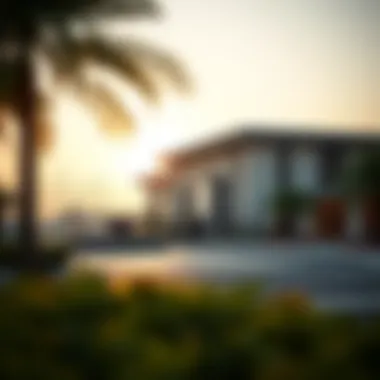Understanding Al Ghubaiba Marine Station's Role in Dubai


Intro
Al Ghubaiba Marine Station is not just a dock; it’s a pulsating artery in the heart of Dubai’s transportation landscape. Nestled along the vibrant Dubai Creek, it offers a unique blend of functionality and tradition, which speaks volumes about the city's ambitious blueprint for growth. As an integral hub for water-based transport, the station caters to both residents and tourists, simplifying access to important destinations across the city.
This article delves deeply into several layers of Al Ghubaiba Marine Station’s role within Dubai’s expanding urban realm. From its historical beginnings to its present-day operations, we will explore how this station fits into the larger picture of real estate development, environmental considerations, and the ongoing urban evolution. Understanding these facets grants valuable insights into how urban planners incorporate such structures into a city known for its rapid transformation and modern strategies.
The Al Ghubaiba Marine Station is not merely a station – it's a symbol of connectivity in a city that thrives on its multicultural tapestry. By dissecting the historical context, operational nuances, and future potential, we will uncover its significance and impact on Dubai’s socio-economic landscape.
Foreword to Al Ghubaiba Marine Station
The Al Ghubaiba Marine Station is more than just a transport hub; it's a testament to Dubai's evolving urban landscape. As the city continuously expands and modernizes, this station has carved its niche by integrating marine transport with the urban fabric. It's crucial to recognize its role, not only in facilitating movement across the waters but also in supporting economic activity and real estate growth in the vicinity. The station acts like a pulse, connecting various parts of the city and engaging both local residents and tourists alike.
Background and Location
Nestled near the bustling streets of Bur Dubai, Al Ghubaiba Marine Station is strategically positioned to capture a diverse passenger demographic. The location provides easy access to prominent landmarks such as the Dubai Museum and the vibrant Dubai Creek area. This prime positioning translates into significant foot traffic, making it an essential point for commuters who wish to traverse the waters of the creek efficiently.
The physical layout of the station is straightforward yet effective. Those stepping off the boats immediately find themselves in an environment that encourages exploration, with shops and eateries just a short walk away. The urban geography around Al Ghubaiba benefits immensely from its maritime access, as it helps reduce road congestion and promotes a greener mode of transport.
Purpose of the Marine Station
At its core, Al Ghubaiba Marine Station is designed to serve the aquatic transport needs of residents and tourists. Ferries and abras frequently depart from here, facilitating quick trips across the creek. This purpose extends beyond mere transportation; it fosters connections. Individuals commuting for work or leisure benefit from a much faster transit option, bypassing the city's notorious traffic jams.
Moreover, the station plays a significant role in promoting tourism. Many visitors opt for the scenic boat rides that offer a unique perspective of Dubai's skyline. This engagement with water transport not only elevates the tourism experience but also adds economic value to businesses that thrive on the local foot traffic generated by the station.
In summary, Al Ghubaiba Marine Station is an essential element of Dubai's urban development narrative. By understanding its background and purpose, stakeholders including investors, real estate agents, and developers can appreciate its significance in shaping the surrounding environment.'
Historical Context
Understanding the historical context of Al Ghubaiba Marine Station illuminates its critical role within Dubai's evolving urban framework. The station, which serves as a poised gateway to both residents and tourists, has roots that intertwine with the wider development of the Emirate. Simply put, it captures the transformation of Dubai from a modest trading port to a bustling metropolis.
Early Development
Al Ghubaiba Marine Station traces its origins back to the early days of Dubai, where the sea was the lifeblood of commerce. Initially established as a simple dock, the station facilitated fishing and trade activities. In those times, it wasn’t unusual to see dhows, the traditional wooden vessels, laden with goods, gently rocking in the harbor’s embrace.
As the city began to blossom following the discovery of oil in the 1960s, the station underwent its first significant transformation. This period marked a shift not only in economic foundations but also in urban design. Al Ghubaiba quickly evolved from a humble point of entry into an essential transportation hub. Investments poured in, leading to new infrastructure developments. New boats and ferries queued up, ready to cater to an increasing population looking for practical transport options across the waterways.
By providing vital links, this station shaped the daily lives of thousands, echoing the needs of a growing city. Merchants, workers, and families all relied upon the station’s routes, which connected various districts with a semblance of ease. The charm of navigating through the water around Dubai’s coastline was becoming a reality for many.
Evolution Through the Years
As time flowed on, the station adapted to meet the demands of an ever-evolving society. The late 1990s ushered in a new era of modernization, leading to comprehensive upgrades. Facilities saw enhancements, boat services were professionalized, and schedules became more efficient.


The introduction of the Dubai Water Canal project in the early 2000s invigorated the station once more. Local and global visitors sought access to luxury waterfront developments, which in turn necessitated further improvements to the station’s infrastructure.
Today, Al Ghubaiba Marine Station stands as a testament to the city's relentless pursuit of progress. It offers a blend of traditional maritime custom and modern convenience, serving as a hub for water taxis and ferries that connect not only the city but also regions beyond. In many ways, the station symbolizes Dubai’s transition, mirroring the urban landscape’s journey from sandy origins to sleek skyscrapers.
The story of Al Ghubaiba Marine Station is also the story of Dubai itself—an ever-adapting city that remains rooted in its rich history while embracing the future.
Through these decades, the station has provided essential services to locals and tourists alike, and its importance is still regarded highly in urban planning discussions. It is clear that Al Ghubaiba is not just a marine station; it represents the heartbeat of Dubai's expansive growth narrative.
Operational Features
Al Ghubaiba Marine Station serves as a critical hub in Dubai's transportation network, intertwining various modes of travel and enhancing connectivity throughout the metropolis. Understanding its operational features provides insights into how it functions not only as a transit point but also as a contributor to the urban landscape. The strong emphasis on operational efficiency and user experience ensures that both residents and tourists can navigate the waterfront with ease.
Types of Services Offered
The station is known for providing a diverse array of services aimed at meeting the needs of its travelers. At the forefront are ferry services that connect various parts of Dubai, including key areas like Dubai Marina and the Palm Jumeirah. These ferries are designed to accommodate a large number of passengers while ensuring comfort and accessibility.
In addition to ferry rides, the station also offers traditional abras, which are small wooden boats that provide a more authentic local experience. This type of service often appeals to tourists seeking to immerse themselves in the culture, while still providing an efficient means of crossing the waterways.
Moreover, Al Ghubaiba Marine Station acts as a gateway for water taxis, which are a frequent choice for individuals looking for a swift travel option to reach specific destinations. Each service is tailored to maximize convenience and to cater to a variety of travel preferences.
Schedule and Frequency
Timeliness is essential in a city that never sleeps. Al Ghubaiba Marine Station adheres to a strict schedule, with ferry services operating at regular intervals throughout the day. This consistency not only aids in passenger planning but also helps to alleviate congestion during peak hours.
Ferry frequency can be broken down as follows:
- Morning rush: Services commence early to cater to commuters heading to work.
- Midday: Frequencies may increase to serve tourists and leisure travelers.
- Evening: Evening services ensure that visitors can return after exploring nearby attractions.
Such operational discipline allows Al Ghubaiba Marine Station to handle the high demand efficiently, maintaining a steady flow of passengers and ensuring minimal wait times.
Capacity and Passenger Flow
Given its location and significance, Al Ghubaiba Marine Station is designed with capacity in mind. It boasts the ability to accommodate thousands of passengers daily, making it a vital component in reducing traffic congestion in the area. The layout provides ample space for movements, ensuring ease of access and enhanced user experiences.
Moreover, passenger flow management is expertly handled through designated waiting areas and boarding points, facilitating organized movement during peak times. Notably, there are even measures in place to ensure that the station does not become overcrowded, which can be particularly challenging during holiday seasons when tourist numbers soar.
"Efficient management of passenger flow at Al Ghubaiba Marine Station can significantly influence the overall experience, making it a vital part of Dubai's identity as a travel hub."
This orchestrated approach to operations, combined with robust services and a commitment to passenger satisfaction, underscores the importance of Al Ghubaiba Marine Station within Dubai's urban framework. Through its operational features, it enhances the mobility landscape for all types of travelers.
Facilities and Amenities
Facilities and amenities play a crucial role in enhancing the user experience at Al Ghubaiba Marine Station. They contribute not only to the functionality of the station but also to its appeal and overall importance within Dubai's urban fabric. With an ever-growing urban population and increasing visitor numbers, the efficient management of these aspects is vital.


Access and Connectivity
Access to Al Ghubaiba Marine Station is one of its strong suits. Located strategically along the Dubai Creek, it boasts proximity to both residential and commercial areas, making it an attractive hub for daily commuters and tourists alike. The station serves as a pivotal link within the broader public transport systems, connecting water taxis, ferries, and traditional abras to local bus and metro services.
- Integrated Transport Options: This seamless connectivity helps reduce congestion on roads, providing a viable alternative for travel across the city.
- Ease of Navigation: Signage and access routes are designed thoughtfully. Passengers can easily navigate the station, with clear directions to various transportation options. It is particularly noteworthy that the station accommodates those with reduced mobility, ensuring inclusiveness.
- Cultural Attractions Nearby: Being near cultural landmarks, such as the Dubai Museum and the Gold Souk, enhances the location's appeal, encouraging foot traffic and boosting local businesses.
Passenger Services
The variety of passenger services at Al Ghubaiba Marine Station is designed to cater to the diverse needs of its users.
- Information Desks: Friendly staff assist with inquiries, helping travelers make informed choices about their journeys.
- Ticketing Services: Automated ticket machines and traditional counters streamline the buying process, reducing wait times. This convenience factor is critical for busy professionals and eager tourists alike. Prices are generally reasonable, contributing to the station's accessibility.
- Waiting Areas: Comfortable seating areas allow passengers to relax before boarding. These spaces are equipped with shade and ventilation, offering enjoyable respite from the heat.
- Food and Beverage Options: Small kiosks provide snacks and drinks, ensuring that, whether someone is embarking on a short trip or a long journey, their needs are met.
Safety Measures
Safety remains a top priority at Al Ghubaiba Marine Station, particularly considering the busy nature of the area and the volume of foot traffic.
- Emergency Services: Trained personnel are always on site, ensuring quick response in case of emergencies. Regular drills and trainings enhance preparedness.
- Surveillance Systems: The station is equipped with CCTV cameras, diligently monitoring activities and ensuring a secure environment for passengers.
- Signage for Safety Protocols: Clear signage informs passengers of safety instructions, including emergency exits and guidelines for behavior on board. It promotes awareness among users about staying safe while enjoying their experience at the station.
- Sanitation Practices: In light of recent global health concerns, stringent cleaning protocols are enforced, maintaining hygiene across facilities used frequently by thousands of passengers.
In summary, the facilities and amenities at Al Ghubaiba Marine Station play an integral role in its function. From access and connectivity to passenger services and safety measures, every element contributes significantly to its standing as a key transportation node in Dubai. As urban areas continue to expand and evolve, such considerations will undoubtedly remain at the forefront of planning and development discussions.
Environmental Impact
The Al Ghubaiba Marine Station is not just a transportation hub; it stands as a vital link between urban development and environmental sustainability in Dubai. In today’s fast-paced world, acknowledging the environmental impact of infrastructure is crucial, particularly as cities expand and evolve. This section delves into specific elements surrounding sustainable practices and the important interactions between human activity and marine life in the context of the station.
Sustainable Practices
Sustainable practices at Al Ghubaiba Marine Station are designed to minimize ecological disturbances while maximizing efficiency. Energy-efficient systems, like LED lighting and solar panels, contribute to reducing the station's carbon footprint. Additionally, the use of recycled materials in the construction and maintenance of the facilities highlights a commitment to environmentally conscious practices.
- Rainwater harvesting systems collect water runoff, which can be utilized for landscaping and maintenance purposes.
- The integration of green spaces around the marine station helps to absorb CO2 and supports biodiversity, creating a small but vital ecological oasis in the heart of the urban sprawl.
"Sustainability isn’t just a trend; it’s a necessity if we wish to protect our marine ecosystems and maintain quality of life in urban areas."
The station also collaborates with international organizations focused on preserving marine ecology, facilitating various workshops and public awareness campaigns. This proactive approach not only informs the public but also encourages local businesses and users of the station to adopt greener practices.
Impact on Marine Life
The marine environment around Al Ghubaiba is vital, as it supports various species of fish, birds, and other marine organisms. However, the station's operations inevitably influence these ecosystems. Balancing development with marine conservation requires continuous effort. The local government has initiated various studies to assess the impact of the station's operations on marine habitats. These studies have shown that while urban development brings about both challenges and opportunities, effective management strategies can mitigate the adverse effects.
- Routine monitoring of water quality is conducted to ensure that pollutants remain within acceptable limits.
- Staff at the marine station participate in environmental stewardship programs, actively engaging with the local community to promote sustainable fishing and boating practices.
Moreover, continuous efforts are required to maintain biodiversity. For instance, the installation of artificial reefs near the station has shown promise in providing habitats for marine life displaced by urban activities. Measures such as these reflect a growing awareness that development must proceed hand-in-hand with conservation efforts.
Real Estate Implications


The Al Ghubaiba Marine Station represents not just a hub of transportation, but also a vital cog in the real estate landscape of Dubai. Its influence extends beyond mere convenience, affecting property values, urban development, and investment potential in the surrounding areas. As the city continues its drive towards modernization and growth, understanding how this marine station interacts with real estate becomes crucial for various stakeholders—be it homebuyers, developers, or investors.
Property Value Trends Near the Station
Properties located in proximity to the Al Ghubaiba Marine Station have shown notable trends in terms of value appreciation. The accessibility provided by ferry services enhances the desirability of residential and commercial spaces alike. This connection is not just about getting from point A to B; it's about lifestyle choices and community cohesion.
- Increased Demand: Areas adjacent to the station, like the bustling markets and cafes, have experienced a surge in demand. Residents value being close to efficient transportation options.
- Rental Yields: Investors are keenly watching these locations, as rental yields have often surpassed benchmarks set in other areas of the city. Many expatriates look to rent close to marine stations for the ease of commuting, making these properties lucrative.
- Forecasted Growth: Real estate analysts predict that as further developments emerge, including potential retail projects and office spaces, property values near the station will continue on an upward trajectory.
"The proximity to a major transport hub can greatly drive up real estate prices. The Al Ghubaiba Marine Station exemplifies this dynamic clearly."
Impact on Local Development Projects
The existence of the Al Ghubaiba Marine Station has catalyzed several local development projects. Urban planners and developers recognize the potential that the station brings in terms of enhanced connectivity and foot traffic. A few noteworthy impacts are as follows:
- Mixed-Use Developments: Projects providing both residential and commercial properties are on the rise. The blending of living and working spaces is increasingly being sought after, facilitating a work-life balance many expect today.
- Public Spaces: More parks, waterfront promenades, and recreational areas are in the planning stages, all aiming to enhance the livability of the area. These developments often increase property values and provide long-term returns for investors.
- Boost to Local Businesses: With easier access, local businesses are seeing improved revenues, encouraging further investment. Increased foot traffic benefits restaurants, shops, and market stalls, creating a vibrant community around the station.
In essence, as Al Ghubaiba Marine Station rises in prominence, it is reshaping not only the immediate urban landscape but also the broader real estate market dynamics in Dubai, highlighting the interdependent relationship between transport infrastructure and property development.
Future Prospects
As Dubai continues to grow and evolve, the Al Ghubaiba Marine Station stands at the cusp of significant change and development. This section examines the potential advancements that could reshape the station, with a keen eye on urban dynamics, environmental considerations, and community needs. Ultimately, understanding the future of this marine hub transcends mere predictions; it defines how it will play a vital role in the broader urban landscape of Dubai.
Predicted Developments in the Area
The geographic positioning of Al Ghubaiba Marine Station makes it a prime candidate for future developments. Various factors indicate that both public and private sectors are looking to invest in enhancements around the station.
- Real Estate Expansion: The station's strategic location is likely to trigger a boom in nearby real estate development. Investors are eyeing opportunities that not only valorize property value but also generate interest in mixed-use developments. As a result, one can expect the emergence of high-rise residential complexes and commercial establishments catering to both locals and tourists.
- Urban Revitalization Projects: Plans are in motion for urban renewal initiatives that will foster better access to public transportation. The aim is to create seamless connectivity between various modes of transport—land and sea. Enhancements could include pedestrian-friendly walkways, cycle paths, and additional docking facilities. This will fundamentally reshape how people engage with the area and its diverse offerings.
- Cultural and Recreational Amenities: With the rising importance of lifestyle experiences, the future may also see cultural centers, galleries, and parks emerging near the station. This aligns with Dubai's vision of creating vibrant neighborhoods, encouraging community participation and tourism alike.
Anticipated Changes in Services
In response to the modernization of the surrounding area, Al Ghubaiba Marine Station is destined for transformative service enhancements that aim to optimize passenger experience.
- Increased Frequency and Variety of Services: As demand rises, the scope of services could expand beyond traditional ferry routes. The introduction of additional maritime transport options such as water taxis or leisure cruises could create a much richer travel experience. People might soon find themselves whisked across the waters with better connectivity to key areas of interest around the city.
- Smart Technologies: To compete with evolving urbanites’ needs, the station may integrate smart technology. This could include mobile apps that provide real-time updates on service schedules and crowd management, making the experience user-friendly. Furthermore, digital information kiosks may enhance navigation and booking systems.
- Visitor Insights and Feedback Incorporation: Understanding passenger needs will become essential. Regular assessments and feedback mechanisms will play a crucial role in refining services offered at the station. As a result, the station may use data analytics to provide a more tailored experience that reflects the desires and preferences of its users.
'The development trajectory of Al Ghubaiba Marine Station could serve as a model for enhancing urban marine services across the globe.'
In summary, the future of Al Ghubaiba Marine Station is not only tied to advancements in technology and amenities but also to a deeper understanding of the community's needs. Real estate developments and service improvements will undoubtedly impact the trajectory of Dubai’s urban fabric, reinforcing the station's place as a key anchor in the city’s growing marine transport network.
End
The significance of Al Ghubaiba Marine Station in Dubai's urban environment cannot be overstated. It serves as a critical junction within the broader framework of the city’s transportation network, linking water transport with other modes seamlessly. This connectivity fosters economic growth by enhancing accessibility, benefiting not only residents but also tourists keen to explore Dubai's diverse attractions.
Summary of Key Points
- Strategic Location: Al Ghubaiba Marine Station's spot by the Dubai Creek makes it an essential point for waterway transit, facilitating smooth commuting for locals and visitors alike.
- Historical Evolution: Its development reflects Dubai’s transformation, illustrating how transportation infrastructure adapts over time to meet urban growth demands.
- Operational Efficiency: With a variety of services and schedules, the station caters to a range of passenger requirements, ensuring effective flows of people and goods.
- Environmental Considerations: The station’s practices promote sustainable transit options that mitigate pollution and support the marine ecosystem in the area.
- Real Estate Impact: The proximity to Al Ghubaiba Marine Station has been linked to rising property values and attracts further developmental projects, shaping the community's future.
Final Thoughts on Al Ghubaiba Marine Station
In closing, Al Ghubaiba Marine Station stands not just as a transit hub but as a pivotal element of Dubai's urban planning strategy. Its influence extends beyond transportation; it encapsulates the essence of Dubai's modernization efforts while respecting its environmental backdrop. For real estate agents, investors, expatriates, homeowners, and developers, understanding the implications of this station provides vital insights into emerging opportunities within the urban landscape. As the station continues to evolve, its role will undoubtedly grow, making it an exciting focal point for anyone interested in the future of Dubai.











